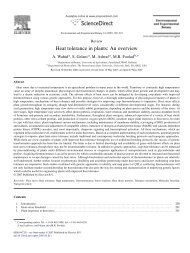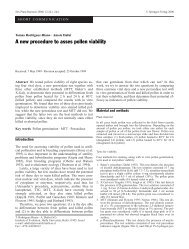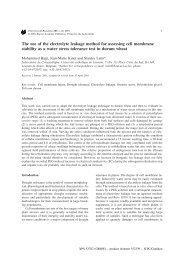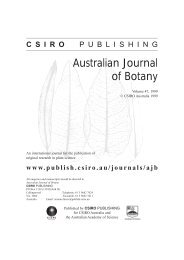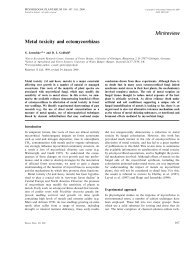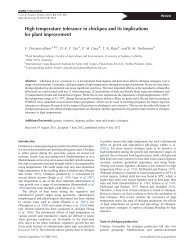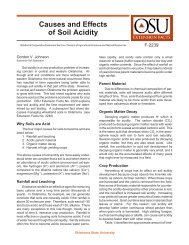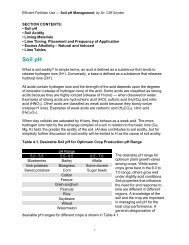Australian Trees for the Rehabilitation of Waterlogged and Salinity ...
Australian Trees for the Rehabilitation of Waterlogged and Salinity ...
Australian Trees for the Rehabilitation of Waterlogged and Salinity ...
You also want an ePaper? Increase the reach of your titles
YUMPU automatically turns print PDFs into web optimized ePapers that Google loves.
706 D. T. Bell<br />
types respond to <strong>the</strong> environment, especially in relationship to tolerance to <strong>the</strong> combined<br />
stress <strong>of</strong> waterlogging <strong>and</strong> salinity, is essential to <strong>the</strong> reclamation process <strong>and</strong> <strong>for</strong> <strong>the</strong> eventual<br />
marketing <strong>of</strong> particular clones. <strong>Australian</strong> genotypes <strong>of</strong> E. camaldulensis have international<br />
marketing potential, but ef<strong>for</strong>ts should be made to retain <strong>the</strong> pr<strong>of</strong>its in <strong>the</strong> country <strong>of</strong> origin.<br />
Seeds have been sold freely or given to overseas organisations, <strong>and</strong> extensive <strong>for</strong>eign<br />
plantations now compete <strong>for</strong> world markets in saw timber, paper pulp <strong>and</strong> oils. More than<br />
500 000 ha <strong>of</strong> E. camaldulensis are planted overseas. Even <strong>the</strong> species’ own epitaph comes<br />
from <strong>the</strong> Camalduli Monastery in Italy where it was cultivated early last century.<br />
Provenance-specific characteristics <strong>of</strong> E. camaldulensis growing in north-eastern Australia<br />
have been exploited to compare details <strong>of</strong> physiological response to arid, semi-tropical<br />
habitats <strong>and</strong> more mesic, monsoonal habitats (Gibson et al. 1991). Provenance differences<br />
were most marked during periods <strong>of</strong> drought stress. <strong>Trees</strong> from arid sites respond to drought<br />
by rapidly limiting shoot growth, an early senescence <strong>of</strong> older leaves <strong>and</strong> <strong>the</strong> production <strong>of</strong><br />
new leaves with a relatively greater ratio <strong>of</strong> dry weight to area (Gibson <strong>and</strong> Bachelard 1994;<br />
Gibson et al. 1994). Seedlings from dry-site provenances produce comparatively more fine<br />
root growth relative to shoot growth <strong>and</strong> reduce allocation to leaves relative to stems (Gibson<br />
et al. 1994). Reduced dry weight allocation to stems <strong>and</strong> leaves in seedlings <strong>of</strong> dry-habitat<br />
provenance is accomplished by <strong>the</strong> shedding <strong>of</strong> lower leaves <strong>and</strong> initiating axillary shoots<br />
with small leaves at lower nodes. Maintenance <strong>of</strong> root production during stress periods in <strong>the</strong><br />
dry provenance seedlings allows longer maintenance <strong>of</strong> transpiration rate when exposed to<br />
water limitation compared with seedlings from <strong>the</strong> humid tropics. On <strong>the</strong> o<strong>the</strong>r h<strong>and</strong>,<br />
seedlings from <strong>the</strong> humid tropics are less responsive to <strong>the</strong> induction <strong>of</strong> drought conditions,<br />
continuing to produce similar leaf morphologies under induced drought conditions, <strong>and</strong><br />
maintain carbon allocation patterns similar to those under more mesic conditions. Lower<br />
transpiration rates in humid tropic seedlings were associated with stomatal closure, increased<br />
water-use efficiency <strong>and</strong> decreased carbon isotope discrimination (Hubick <strong>and</strong> Gibson 1993).<br />
In addition to provenance selections, a range <strong>of</strong> highly tolerant clones <strong>of</strong> Eucalyptus<br />
camaldulensis genotypes has been selected (McComb et al. 1989; van der Moezel <strong>and</strong> Bell<br />
1990) <strong>and</strong> field-trialled (Bell et al. 1993c, 1994) <strong>for</strong> reclamation purposes. The two clonal<br />
lines, M66 <strong>and</strong> M80, from <strong>the</strong> Marrinup Nursery <strong>of</strong> Alcoa <strong>of</strong> Australia Ltd, have been used in<br />
a range <strong>of</strong> studies related to <strong>the</strong> rehabilitation <strong>of</strong> waterlogged <strong>and</strong> saline l<strong>and</strong>. The comparison<br />
provides insights into <strong>the</strong> anatomical, morphological <strong>and</strong> physiological interactions which<br />
lead to an ability to cope with waterlogged <strong>and</strong> saline habitats. The M66 line originated from<br />
a tree growing near Erudina, South Australia, <strong>and</strong> M80 originated from Wooramel, Western<br />
Australia (Table 2). Both habitats are arid, but Erudina has lower annual rainfall <strong>and</strong> a higher<br />
ratio <strong>of</strong> evaporation to rainfall. James <strong>and</strong> Bell (1995) found that <strong>the</strong>se two genotypes share<br />
one enzyme locus (MDH-2), but differ in four o<strong>the</strong>rs (PGI, PGM, SDH <strong>and</strong> SOD). Of a<br />
number <strong>of</strong> clones compared in detail, M66 <strong>and</strong> M80, in addition to being genetically <strong>the</strong> most<br />
dissimilar, are <strong>the</strong> most dissimilar in terms <strong>of</strong> leaf anatomy <strong>and</strong> morphology. The leaf <strong>of</strong> <strong>the</strong><br />
M66 clone is shorter than that <strong>of</strong> M80, but wider <strong>and</strong> thicker (Table 2). M66 leaves tend to be<br />
more glaucous <strong>and</strong> blue-green, with M80 showing a more true green to yellow-green. Cuticle<br />
thickness in M66 is nearly double that <strong>of</strong> M80. M66 tends to have fewer but larger stomata<br />
although stomatal density <strong>for</strong> both clones tends to be high in comparison with o<strong>the</strong>r species<br />
<strong>of</strong> Eucalyptus (Cameron 1970; Ridge et al. 1984; Kumar <strong>and</strong> Rao 1985). M66 is, <strong>the</strong>re<strong>for</strong>e,<br />
more typical <strong>of</strong> plants growing in xeric, high-light habitats, producing leaves with smaller<br />
area, but a greater thickness (Abrams et al. 1994), with a high ratio <strong>of</strong> volume to leaf surface<br />
(Bolhar-Nordenkampf 1987). Cuticle thickness is most <strong>of</strong>ten associated with high light<br />
environments (Igboanugo 1992). In general, <strong>the</strong> greater <strong>the</strong> density <strong>of</strong> stomata, <strong>the</strong> smaller<br />
<strong>the</strong>y will be (Tisha 1985). Increased number <strong>and</strong> smaller-sized stomata allow <strong>for</strong> more<br />
flexible regulation <strong>of</strong> water loss; carbon dioxide uptake is <strong>the</strong>re<strong>for</strong>e maintained when <strong>the</strong><br />
relative humidity <strong>of</strong> <strong>the</strong> air is low (Bolhar-Nordenkampf 1987).



